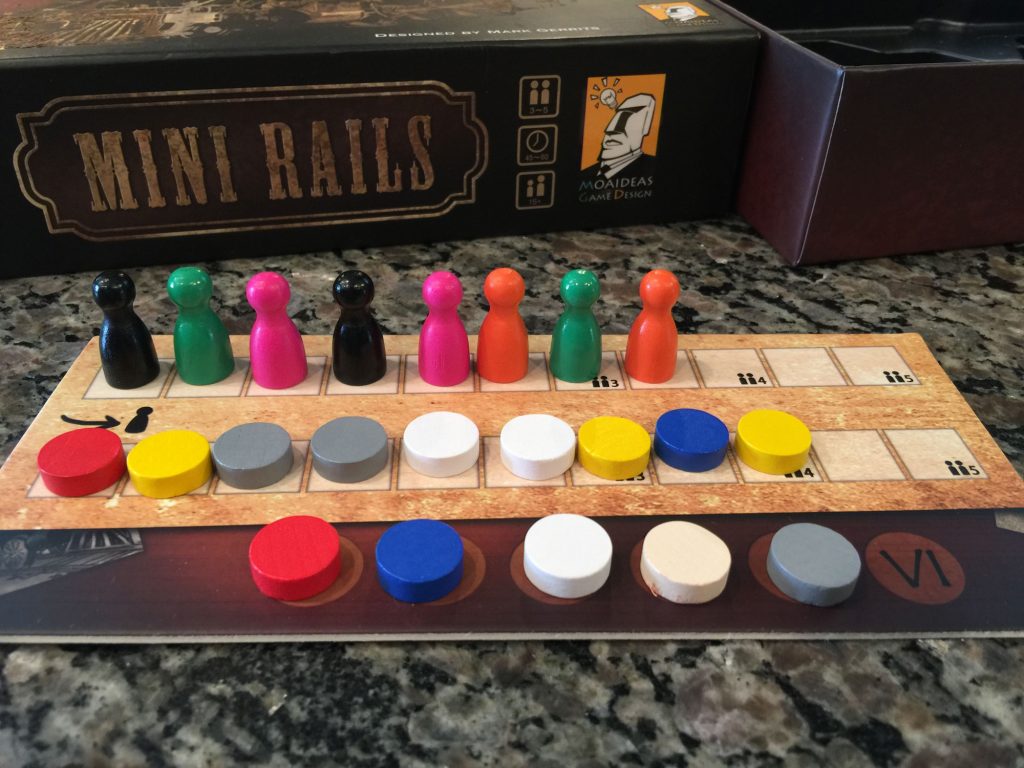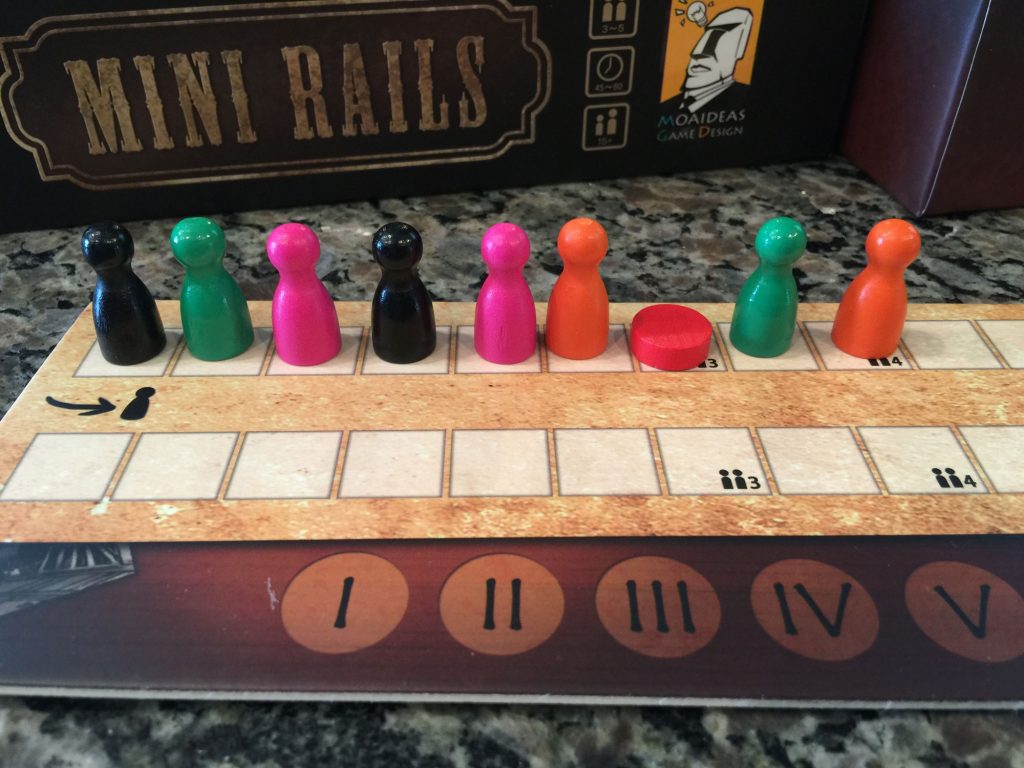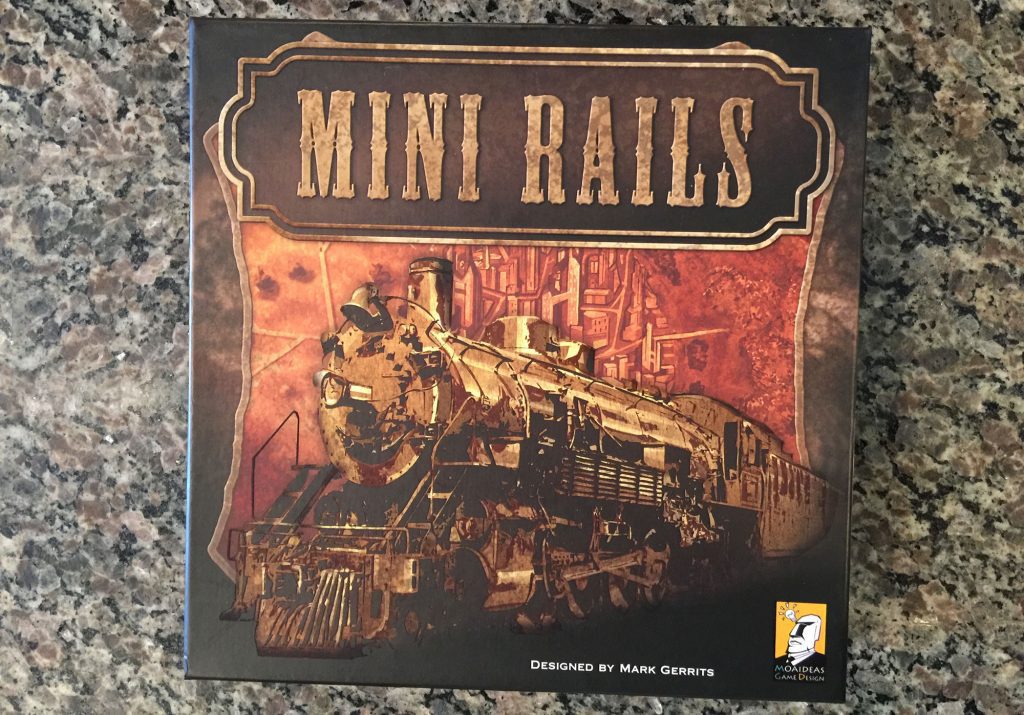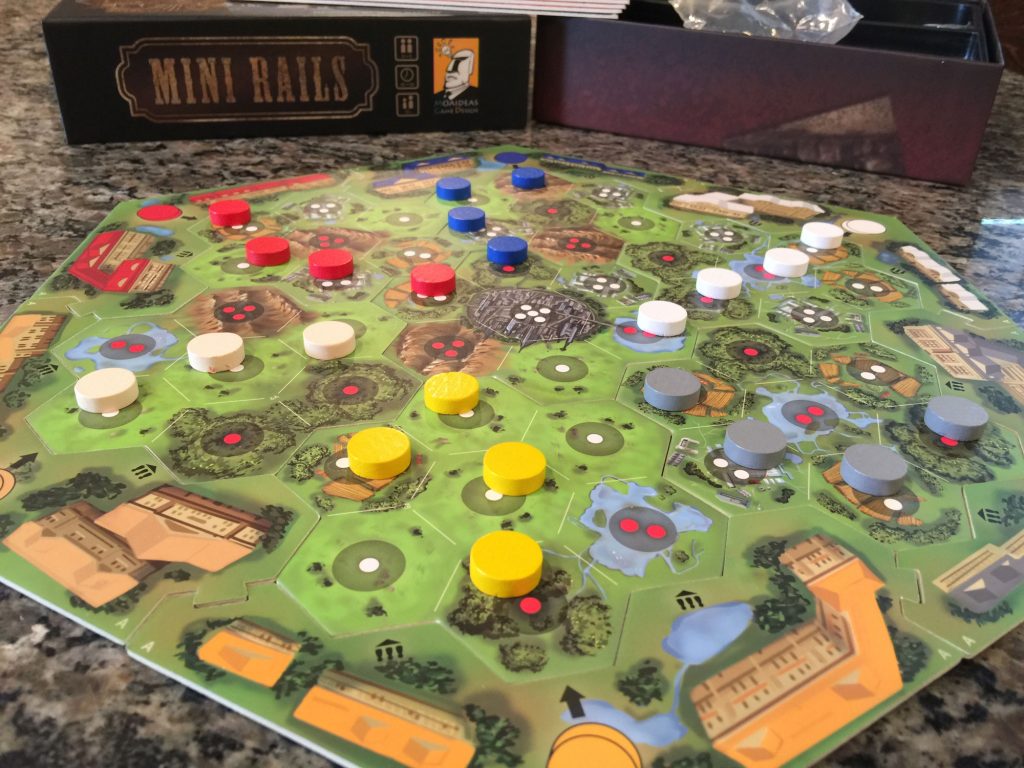I first heard about Mini Rails, from Mark Gerrits, on the BoardGameGeek Twitter account and I was immediately struck by its tiny size and attractive graphic design. As I started reading more about I realized that it had almost everything I love in one game. Fixed number of turns? Modular board? Touch choices? Short play time? Variable setup? Check, check, check, check, and CHECK!
I immediately contacted the publisher, Moaideas, to see about getting a copy. A few weeks later I received a package from Taiwan containing Mini Rails, safely nestled in its protective wrapping. I’ve played it a number of time since and I’m in love! Let’s walk through the basics of the game and then I’ll wrap it up with some final thoughts!
Mini Rails Overview
Mini Rails plays out over 6 turns and pits players against each other as rival industry barons fighting for the placement of railroad tracks which will best increase their investments in the 6 companies of the game (represented by 72 discs, 12 each of 6 different colors). Each player will have exactly 2 turns per round: one chance to lay track on the board, and one chance to invest in stock for a given company.

At the end of the six rounds, six pieces will remain unchosen on the board which will dictate scoring for the game.
Setting Up Mini Rails
Setting up Mini Rails is easy and fun. Remove all the map and border pieces, then assemble them, with the map tile featuring five dots being placed in the center. This represents the main part of the city and is consequently worth the most points.

Give each player their own board, 2 player pawns, and their stock and train tokens. Chose a starting player and have that person place their pawns on the first space of the top section of the scoring (or Market) board. In clockwise order each other player adds their piece to the next space on the board until the last player who places both of their pieces. Placement then proceeds counterclockwise until all players have placed their pieces, as you can see below. This board will act as both the turn order track, as well as dictating which pieces players will select throughout the game.

Using the chart in the rulebook, add the correct number of colored discs to the bag and board, then return the rest to the box. Draw 2 pieces for each player (plus one) from the bag and place them on the track in the middle section of the scoreboard.
This part of the setup threw me off because the top and middle sections are clearly labeled with a player count 3, 4, and 5. The count on the turn order track specifically indicates the number of discs to lay down on the board and does not indicate the player pieces.
The Anatomy of a Round
A round in Mini Rails consists of each player performing two actions in turn order. One action allows them to lay track on the board, while the other allows them to invest in a company of their choice. In both cases the current player takes their pawn, selects one disc from the board, places their pawn in its place, then decides which action to perform.

So what do your actions accomplish? Let’s start by buying stock in a company. Take the colored disc you selected and place it on the far left side of your board. That’s it, congratulations you’re now part owner in a railroad company!

If a player chooses to lay track, they take their selected piece and lay it anywhere on the board which connects to that company’s rail yard on the outside of the board.

Any player who owns stock in that company will adjust their holdings according to the number of pips on that space. Spaces with white dots provide players a positive lift to their investment, while red dots reduce stock value in the same fashion.
This tightly restrictive set of choices is highly appealing because it means that you have to be very careful about your choices. You’re only taking twelve total turns in the game which means you have a LOT to accomplish in a short amount of time. Luckily other players may help you as they attempt to help themselves. But watch out for low hanging fruit whereby an opportunistic player manipulates tracks or stocks in a way that negatively impacts you.
Scoring and Hair-pulling
Observant readers will remember that there will be one extra disc on the Market board at the end of the round. The wickedly clever part of this game is that the leftover disc dictates what companies score at the end of the game. At the end of each round, the last unchosen disc moves down to the bottom of the scoreboard (the Taxed Area) in what is called the Taxation phase. This piece acts as both a round marker and scoring trigger, in the following manner:
- For every company with at least one disc in the Taxed Area, remove all discs of that color in the negative zone (bottom) of a player’s board.
- For every company that has no discs in the Taxed Area, remove all discs of that color from the positive zone (top) of a player’s board.
- The remaining pieces on your board will be added up and constitute your score.
The Components
Before I give you my final thoughts let’s take a quick look at the components. The box is the same size as Kahuna, or Patchwork, and you’ll be surprised just how much fits inside.

The insert is well designed and has slots for everything in the box.

There’s no wondering what goes where with this game. Kudos to Mark and Moaideas there.

The map tiles are thick and well made, the modular board assembles (and disassembles) easily, and the artwork tiles across all of the pieces seamlessly.

The included canvas bag has the game’s logotype silk-screened on it, and feels good. The included discs are easy to pick up and colorful but have one glaring flaw. Included in the bag are white and creme colored discs. In the wrong light these discs are very difficult to distinguish and several times I had to use my phone’s flashlight to make sure which was which.

The color printed on the board is a darker brown so I assume this was an accident on the part of the printing company. That said Moaideas should really have done something to make it easier to tell these colors apart.
Update: While at Gen Con I came across the Moaideas table and noticed that the publisher is including an update to the creme colored discs. If you’ve already received a copy, contact the publisher through the Moaideas Facebook page to request a replacement. If you’re purchasing a new copy then rest assured you won’t have this problem.
Final Thoughts
Man oh man I love this game. It’s tight, tense, well designed, and makes you want to slap your opponent when they choose that ONE color you need to wind up in the Taxed Area. Because there’s also a fixed number of pieces of each company in the bag you have to pay close attention to what other players are doing.
Do you choose the red piece because you want to make your stock increase in value, but take the risk of that color not winding up at the bottom of the board at game’s end? Do you take a token that won’t directly benefit you just to interfere with your opponent’s plans? Do you attempt to cooperate with another player in hopes they’ll reciprocate? Note that cooperation is not explicitly part of the rules, but why not try right?

In the games I’ve played the scores have ranged between 5 and 20, but primarily scores average between 8 to 15. So you can see that a 3 or 4 point stock is a big deal. Mini Rails plays fast, turns are simple, yet agonizing, and in more than one case I’ve yelled out loud because I needed to do BOTH actions on a turn instead of just one.
Moaideas will have a limited stock of Mini Rails at Gen Con, and could wind up licensing this game to an American publisher soon. That said if you can get your hands on this game it’s WELL worth the price.
UPDATE: As an added bonus it looks like Tasty Minstrel Games will be distributing Mini Rails for Moaideas. This is exciting news as it will get this great game into the hands of a much larger audience!
Looks like @TastyMinstrel will be distributing Mini Rails for @moaideas! Read our review! https://t.co/6A8OtGqo4u pic.twitter.com/5vtL7gGSgk
— MeepleMtn @ Gen Con! (@meeplemountain) August 19, 2017










